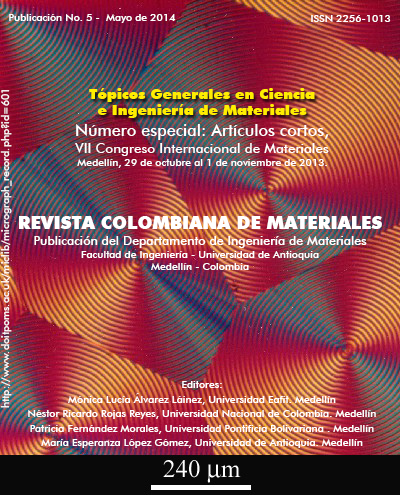.
DOI:
https://doi.org/10.17533/udea.rcm.19452Keywords:
Oxygen carries, Wet impregnation, y-Al2O3, Copper oxideAbstract
Downloads
References
A. Abad, J. Adánez, F. García-Labiano, L. F. de Diego, and P. Gayán, “Modeling of the chemical-looping combustion of methane using a Cu-based oxygen-carrier,” Combustion and Flame, vol. 157, no. 3, pp. 602–615, Mar. 2010. DOI: https://doi.org/10.1016/j.combustflame.2009.10.010
J. Adanez, A. Abad, F. Garcia-Labiano, P. Gayan, and L. F. de Diego, “Progress in Chemical-Looping Combustion and Reforming technologies,” Progress in Energy and Combustion Science, vol. 38, no. 2, pp. 215–282, Apr. 2012. DOI: https://doi.org/10.1016/j.pecs.2011.09.001
H. Fang, L. Haibin, and Z. Zengli, “Advancements in Development of
Chemical-Looping Combustion: A Review,” International Journal of Chemical Engineering, vol. 2009, no. ii, pp. 1–16, 2009. DOI: https://doi.org/10.1155/2009/710515
J. Celaya, “Combustión de CH4 en lecho fluidizado con separación inherente de CO2 por medio de transportadores sólidos de oxígeno de base cobre,” Tesis Doctoral. Universidad de Zaragoza, 2007.
P. Gay, C. R. Forero, A. Abad, L. F. De Diego, F. García-labiano, and J. Ad, “Effect of Support on the Behavior of Cu-Based Oxygen Carriers during Long-Term CLC Operation at Temperatures above 1073 K,” Energy & Fuels, vol. 25, pp. 1316–1326, 2011. DOI: https://doi.org/10.1021/ef101583w
C. R. Forero, P. Gayán, F. García-Labiano, L. F. de Diego, a. Abad, and J. Adánez, “High temperature behaviour of a CuO/γAl2O3 oxygen carrier for chemical-looping combustion,” International Journal of Greenhouse Gas Control, vol. 5, no. 4, pp. 659–667, Jul. 2011. DOI: https://doi.org/10.1016/j.ijggc.2011.03.005
Q. Zafar, T. Mattisson, and B. Gevert, “Redox Investigation of Some Oxides of Transition-State Metals Ni, Cu, Fe, and Mn Supported on SiO2 and MgAl2O4,” Energy & Fuels, vol. 20, no. 1, pp. 34–44, Dec. 2005. DOI: https://doi.org/10.1021/ef0501389
J. Adánez, L. F. de Diego, F. García-Labiano, P. Gayán, A. Abad, and J. M. Palacios, “Selection of Oxygen Carriers for Chemical-Looping Combustion,” Energy & Fuels, vol. 18, no. 2, pp. 371–377, Jan. 2004. DOI: https://doi.org/10.1021/ef0301452
M. M. Hossain and H. I. de Lasa, “Chemical-looping combustion (CLC) for inherent separations—a review,” Chemical Engineering Science, vol. 63, no. 18, pp. 4433–4451, Sep. 2008. DOI: https://doi.org/10.1016/j.ces.2008.05.028
C.R. Forero, J. Adánez, P. Gayán, L.F. de Diego, F. García-Labianos, A. Abad. "Captura de CO2 mediante transportadores sólidos de oxígeno". Revista Colombiana de Química, vol 39, no.2, pp. 271-285, 2010.
V. Jiménez, “Síntesis , activación química y aplicaciones de nanoestructuras de carbono,” Tesis Doctoral. Universidad de Castilla, 2011.
Micromeritics, “ASAP 2020. Accelerated Surface Area and Porosimetry System” 2011. [Online]. Available: http://www.micromeritics.com/product-showcase/ASAP-2020-Physisorption.aspx.








